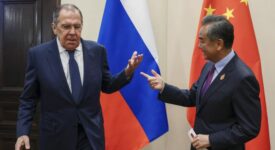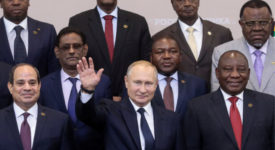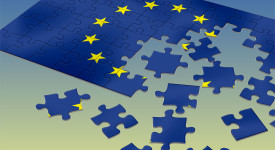A Window of Opportunity to Upgrade EU Foreign Policy
Stefan Lehne (Carnegie Europe)
For the United States, the continuing and in many respects deepening crisis in Ukraine clearly presents an unwanted burden. With any signs of improvement or nascent solution to the conflict, the US is likely to end its engagement in the region and resume its pivot to Asia. For this reason, the EU should stop relying on the help of others and instead begin creating an effective common foreign and security policy. Although currently overshadowed by the events in Eastern Europe, the continuing instability in North Africa is likely to present the most daunting of challenges for European security in the next decade.
The prospects for EU foreign policy betterment will largely depend on the will to act of the new leadership teams in the European Commission and the European Parliament and their determination to reorganise the Commission. Catherine Ashton, the incumbent High Representative of the Union for Foreign Affairs and Security Policy, will be remembered chiefly for her role in easing tensions between Serbia and Kosovo, securing an interim agreement with Iran over its nuclear programme, and setting up of the European External Action Service (EEAS). These successes notwithstanding, the appointment of Ashton as the High Representative came as a surprise to many given her lack of experience with foreign policy.
The candidate selection for this post is a useful hint of the subsequent direction the EU will take in its foreign policy. For example, the appointment of then NATO secretary general and former Spanish foreign minister Javier Solana raised the profile of the EU’s foreign policy at a time when it was being marginalised by the US in the context of the Kosovo war. A fruitful reorganisation of the Commission will seek to organise the Commission portfolios into five to seven topically related clusters centred on key tasks, such as administration, citizenship, economy, external relations, and natural resources. The external relations cluster will encompass trade, development, the neighbourhood, enlargement, and humanitarian assistance. At the same time, it will be placed under direct authority of the High Representative.
One should not expect this reorganisation to bring revolutionary changes. After all, the foreign policy sector remains largely in the hands of national governments. However, it is a step in the right direction towards a more effective EU foreign policy.
(The study can be downloaded here: http://carnegieeurope.eu/2014/05/02/window-of-opportunity-to-upgrade-eu-foreign-policy/h9sj)
The Vilnius Summit and Ukraine’s Revolution as a Benchmark for EU Eastern Partnership Policy
Tomislava Penkova (Istituto per gli Studi di Politica Internazionale)
Following the November 2013 Vilnius summit, three phenomena may be observed and evaluated: a) the moment of surprise and disappointment following Yanukovich’s refusal to sign the Association Agreement with the European Union, b) a growing number of calls for the reform of the Eastern Partnership, and c) pivotal influence Russia played in the Eastern Partnership since the crisis in Ukraine started.
Even though the EU expected the Vilnius discussions to bear positive results, the first cloud on the horizon appeared in September when Armenia expressed its wish to enter a border deal with Russia, Belarus, and Kazakhstan. The greatest shock came after Yanukovich refused to sign the Association Agreement with the EU. Until then, Europe was too confident in its politics and presented Ukraine as a model state for its reforms. In doing so, the EU failed to understand political developments in the country, unlike Russia, which approached its relations with Ukraine with a great degree of pragmatism. After Yanukovich’s decision, the EU appealed to Moldavia and Georgia and these two countries became new models for its reform programme. Following the Maidan protests, this ‘privilege’ position was restored to Ukraine.
The EU should take six lessons from the security crisis in Ukraine. First, the European Partnership encompasses a range of states whose interests fundamentally differ, and should be expected these differences to persist in the future. Second, the EU should maintain high levels of political involvement. Third, it should seek to garner support from the civic, business and local government circles in the associated states. Fourth, it must find better and more accessible ways of explaining its ideological values. Fifth, it should offer its partner states protection from external influences (in this case pressure from the Kremlin). Finally, sixth, the EU should maintain a dialogue with Russia over political developments in post-Soviet countries so as to avoid regional political polarisation. The greatest weakness of the Eastern Partnership is that it only offers a choice between two options. However, post-Soviet states need to maintain good relations with all of its influential neighbours, including Russia. The EU should therefore tailor its foreign policy to fit the needs of its partners rather than its own.
(The study can be downloaded here: http://www.ispionline.it/en/pubblicazione/vilnius-summit-and-ukraines-revolution-benchmark-eu-eastern-partnership-policy-10187)
The Governance of Migration, Mobility and Asylum in the EU: A Contentious Laboratory
Giulia Henry and Ferruccio Pastore (Istituto Affari Internazionali)
This study analyses three themes associated with the movement of people: the right to free mobility, migration, and asylum politics. A plethora of political approaches exists within the EU to tackle these themes, each with its own institutional agenda. One may ask whether the many different types of movement which characterise the present situation mandate a more interconnected response.
The right to free movement constitutes one of the four key rights of EU citizenship and is part of the EU acquis. Free movement may be partially limited in the case of the newly acceded Member States’ access to the EU-wide labour market. The expiration of such limits in Bulgaria and Romania, coupled with the continued fear of Europe-wide economic crisis, sparked concerns in Britain, Germany and elsewhere and initiated discussions with the European Commission over the possibility of revising the common approach to free movement. However, any changes in the current setting are likely to lead to a further collapse of legitimacy of the EU in its peripheral Member States. Making use of youth programmes in the poorest states seems like an effective solution, leading to economic improvement in crisis-stricken states and a subsequent decline in labour migration.
The Schengen Area plays a significant role in the migration question. Member States have agreed on common Schengen visa requirements for the entry of citizens from non-EU countries. However, labour migration may be limited by individual Member States. Related to this theme is the common European asylum system agreed in the Dublin Regulation. The fight against illegal migration across the Mediterranean was almost won in 2010, but the problem became significantly worse following the collapse of former North African states’ oppressive regimes and the deepening of the economic crisis, leading to discussions over stricter Schengen border controls. As a result of the tragedy near Lampedusa, the Dublin Regulation was revised, an early warning mechanism created, and tools for “practical cooperation” put in place.
However, the EU’s asylum politics and its management of illegal migration necessitates a closer cooperation and solidarity between all EU Member States, including those less affected ones and the wealthier northern European states. A new approach should be developed, which will understand migration as a complex issue involving, among others, also the problems of labour migration, asylum seeking, family reunification etc., while seeking to actively prevent illegal immigration from increasing and promote safe channels for legal entry into the EU space. Migration and mobility constitute some of the most difficult challenges for the Italian Presidency of the EU. Given the differing interests of individual Member States in this field, a transnational synchronisation of labour migration is not likely in the medium-term.
To conclude, the right to free movement should be maintained. Attempts to question this fundamental principle may hamper trust in the EU in its peripheral Member States. Tackling immigration as a multifaceted phenomenon will prove most challenging given the lack of initiative and will to cooperate, especially from the ranks of wealthier northern Member States. The rules concerning labour migration are likely to be harmonised transnationally in the future together with other rules of economic governance. Yet, for the time being, it is uncertain when exactly this will happen.
(The study can be downloaded here: http://www.iai.it/content.asp?langid=2&contentid=1112)







